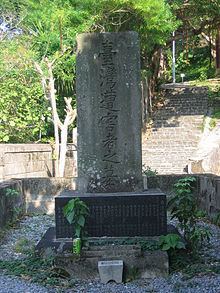Perpetrators Paiwan Formosans Location Taiwan, Taiwan Attack type Massacre | Date 1871 Total number of deaths 54 | |
 | ||
Victim Ryukyuan people who wandered into Taiwan whose ship carrying tribute to Shuri shipwrecked | ||
0604 19 mudan incident
The Mudan incident of 1871 was the massacre of 54 Ryūkyūan sailors in Qing-era Taiwan who wandered into the central part of Taiwan after their ship was shipwrecked. 12 men were rescued by Han Chinese and were transferred to Miyako. Japan sent a military force to Taiwan in the Taiwan Expedition of 1874 in retaliation for the murdered Ryukyuan sailors, in retailiation for what Japan viewed as the murder of their citizens by rebellious aboriginal peoples out of the control but in the dominion of the failing Qing dynasty.
Contents
- 0604 19 mudan incident
- Shipwreck
- Crossing Taiwan
- Yang Youwang
- People who rescued the 12 sailors
- Victims and Survivors
- Diplomatic conflicts and Taiwan Expedition of 1874
- Tomb and afterwards
- Shimabukuro Kame
- References
Shipwreck
On October 18, 1871, four ships which had carried the poll tax to the Ryūkyū Kingdom started from Naha for their homeland. They met a violent typhoon and one ship disappeared, one ship sailed safely, and two ships were shipwrecked; one reached the eastern tip of Taiwan on November 6. Another ship reached the western part of Taiwan and this one was safe.
Crossing Taiwan
There were 66 people who landed on November 6, at the eastern tip of present-day Manzhou, Pingtung in southern Taiwan, but three people who landed in a hurry died during landing. They began traveling in difficult conditions for safety. According to two survivors, they reached the Mudan community (Chinese: 牡丹社; Pe̍h-ōe-jī: Bó͘-tan-siā) on November 8 and were ordered to stay there by the local Paiwan people; there 66 men and women had some doubts and on November 9, tried to escape. That is when the massacre began; 12 survivors were rescued by local people and stayed there for 40 plus several days, in the house of Yang Youwang. They returned via Taiwan-fu (modern-day Tainan) and Fuzhou, Fujian and they came back to Miyako. The distance of their wandering was roughly 100 km, across a map. The place of the massacre was known as Mudan (雙溪口).
Yang Youwang
12 survivors stayed at Yang Youwang's home for 40 plus several days and they recovered with sufficient food. He paid a considerable amount of money to calm down the aborigines. Originally they got angry for not being given two barrels of alcohol. Yang Youwang's son and nephew brought the 12 survivors to safety. They stayed at the Ryukyuan embassy at Fuzhou for half a year and the survivors reached Naha on June 7, 1872, together with the men on another ship, which reached Taiwan on their way to Yaeyama. Yoh and other people made a tomb and have continued memorial ceremonies.
People who rescued the 12 sailors
Victims and Survivors
Diplomatic conflicts and Taiwan Expedition of 1874
The Japanese Government demanded that the Chinese government punish leaders of the Taiwanese aborigines, but their response was that they were not under the control of the Chinese Government and the Japanese Government decided on sending the Japanese army in the Taiwan Expedition of 1874.
Tomb and afterwards
The Japanese expedition army established a memorial tower in front of the tomb where Taiwanese rescuers made, and collected skulls, 44 skulls; 10 skulls could not be recovered. The skulls were transferred first to Nagasaki and then to Naha and buried there and later at Gokoku-ji (Okinawa) in the same city. In 1980, the tomb was made again anew, and related people attended the ceremony from Miyako Island. In 1997, Fumio Miyakuni visited the related places and wrote a book. In 2005, Taiwanese people visited Miyako Island for an apology and they and Miyako people shook hands in friendship.
Shimabukuro Kame
Shimabukuro Kame (1850–1926) was a survivor and an important informant concerning the incident and victims. His father and he were lower class peichin without salary living at Shuri, Okinawa; there were 5 victims living at Shuri, and they were being given a lift on the ship. In 1872, his father and he were interviewed by the Ryukyu government. After the abolition of the clan, what they did was not known. In 1925, Kame sent a letter to Iha Fuyū who introduced Teruya Hiroshi who gave the address of rescuers, since Kame wanted to thank them. Teruya Hiroshi was deeply moved and after the addresses of Miyako victims were investigated by Motomura Choryo, the names of the victims were engraved into the tombs of both Taiwan and Naha.
Teruya Hiroshi (1875–1934) was born in Naha and studied at Daiichi Higher School and Tokyo University. He became a train engineer in Taiwan and later became the Mayor of Naha.
Motomura Choryo (1876–1937) was the town head of Hirara between 1917 and 1919. He gave information on Miyako victims.
